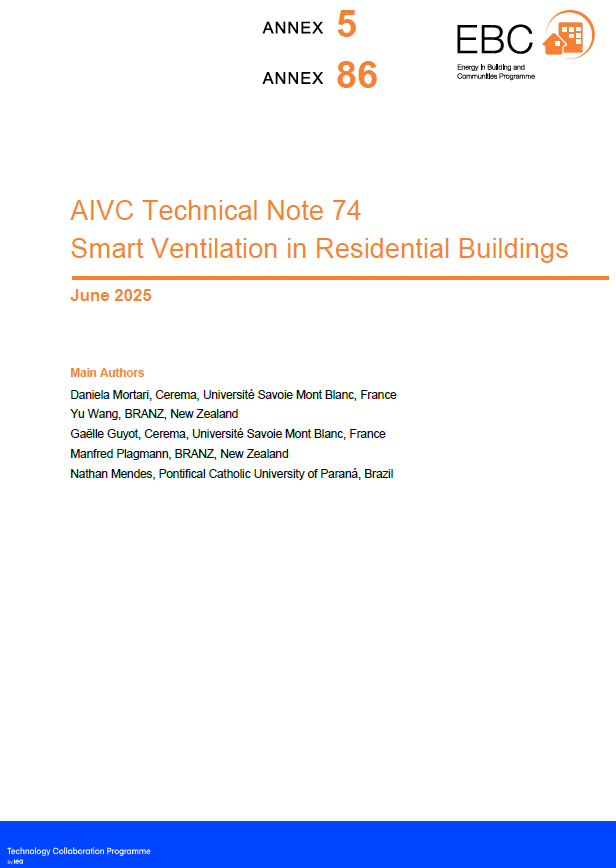An ideal ventilation system should be robust and capable of providing thermal comfort and good indoor air quality (IAQ) that safeguards occupant health while also minimising space conditioning costs and reducing auxiliary energy use for fans. Experts from the Air Infiltration and Ventilation Centre (AIVC) have defined smart ventilation as “a process to continually adjust the ventilation system in time, and optionally by location, to provide the desired IAQ benefits while minimising energy consumption, utility bills, and other non-IAQ costs, such as thermal discomfort or noise” (Durier et al., 2018, p. 38). The key concept of smart ventilation is to use controls to ventilate more when it provides either an energy or IAQ advantage or other non-IAQ cost and less when it provides a disadvantage. The fundamental goal of this concept is to reduce ventilation energy consumption while maintaining the same IAQ or achieving better IAQ in comparison to a continuously operating or constant airflow ventilation system. The parameters that smart ventilation systems can respond to include, but are not limited to, occupancy, indoor contaminants, outdoor temperature and humidity, outdoor air quality, electricity grid needs and the operation of other air moving or cleaning systems. Smart ventilation includes demand-controlled ventilation (DCV), which responds to the direct sensing of indoor contaminants.
The publications on residential smart ventilation systems between 1979 and 2016 were reviewed (Guyot et al., 2018), including the development of smart ventilation in the International Energy Agency (IEA) annexes, the types of commonly available smart ventilation systems and the challenges in the comparison of IAQ performance and energy savings resulting from the implementation of these smart ventilation systems. This previous review showed that up to 60 % of ventilation energy savings can be obtained without compromising IAQ.
Since 2016, there have been many new developments in residential smart ventilation. For example, formaldehyde (HCHO) and particulate matter (PM) have been used to develop control strategies (Johnston et al., 2020). The combination of ventilation and filtration controls has been used to maintain indoor PM2.5 within an acceptable level and minimize energy consumption (Kim et al., 2020). The indicator of dynamic disability adjusted life years (DALYs) has been developed and applied to investigate the impact of IAQ in households with smart ventilation on occupants’ health, as well as the energy consumption associated with the ventilation (De Jonge and Laverge, 2022). The impact of changing the number of occupants on non-occupant dependent pollutants exposure, i.e., volatile organic compounds (VOCs) when ventilation is controlled by occupants generated pollution, such as relative humidity (RH) and carbon dioxide (CO2) has been investigated (De Jonge et al., 2023). Decentralized ventilation units are investigated to suit the apartment settings and retrofit the existing house to avoid the possible challenges due to the lack of space for the installation of ducts and air handling units (Carbonare et al., 2020, 2019; Filis et al., 2023). In conjunction with the IAQ performance and energy consumption by ventilation system, the potential for mold growth at the window surface has been investigated (Shin et al., 2018). The simulation of humidity-based DCV in the whole high-rise building, including 23 units, is also a new development (Sowa and Mijakowski, 2020). The data-driven approach has been used to develop control strategies (Han et al., 2022). The large-scale field performance analysis of the demand-controlled mechanical extract ventilation (DCMEV) systems has been published (De Maré et al., 2019).
Today, energy savings in the building sector are in high demand, as is the need to provide an acceptable IAQ, which means ventilation plays an even more critical role. Since residential buildings are often unoccupied or occupied at a lower level, the smart ventilation strategy is extremely important to achieve the high potential of energy savings and assure good IAQ.
In the context of the emergence of new developments in residential smart ventilation and high demand for energy savings and providing acceptable IAQ, this review is conducted with the aim of summarising the evidence of the benefits of implementing smart ventilation in residential homes. It focuses on ventilation strategies and their effectiveness, which consists of IAQ benefits, non-IAQ benefits (such as thermal comfort and noise), minimising energy consumption and minimising utility bills, and other advantages related to indoor environmental quality (IEQ).
This review seeks to answer two questions:
- What strategies have been investigated for smart ventilation systems in residential buildings?
- How effective are these smart ventilation strategies in improving IAQ and thermal comfort and minimising energy consumption?
This study is within the scope of IEA Energy in Buildings and Community (IEA EBC), Annex 86: “Energy Efficient Indoor Air Quality Management in Residential Buildings” focused on subtask 4 “Ensuring performance of smart ventilation”, which points to the necessity of reviewing existing smart ventilation strategies (IEA EBC, 2020, p. 86). It is important to highlight that the focus of this review is to analyse smart ventilation strategies applied in residences and their effectiveness in improving IEQ and reducing energy consumption. In this context, we included papers addressing these two pillars. Therefore, related topics such as sensor development and evaluation of ventilation system durability are out of the scope of this review. It is recognised that source control is the essential initial step towards attaining good IEQ. However, this aspect also falls beyond the scope of this review. The smart ventilation strategies presented in this review can contribute the further development of smart ventilation, reducing energy consumption and improving IEQ. In addition, the wide range of described systems can provide a technical reference framework for professionals involved in building new dwellings and renovation processes that are currently facing a lack of knowledge and decision tools to choose, design and install the most efficient and suitable systems in residential buildings.





